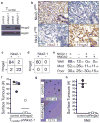Suppression of lung adenocarcinoma progression by Nkx2-1
- PMID: 21471965
- PMCID: PMC3088778
- DOI: 10.1038/nature09881
Suppression of lung adenocarcinoma progression by Nkx2-1
Abstract
Despite the high prevalence and poor outcome of patients with metastatic lung cancer the mechanisms of tumour progression and metastasis remain largely uncharacterized. Here we modelled human lung adenocarcinoma, which frequently harbours activating point mutations in KRAS and inactivation of the p53 pathway, using conditional alleles in mice. Lentiviral-mediated somatic activation of oncogenic Kras and deletion of p53 in the lung epithelial cells of Kras(LSL-G12D/+);p53(flox/flox) mice initiates lung adenocarcinoma development. Although tumours are initiated synchronously by defined genetic alterations, only a subset becomes malignant, indicating that disease progression requires additional alterations. Identification of the lentiviral integration sites allowed us to distinguish metastatic from non-metastatic tumours and determine the gene expression alterations that distinguish these tumour types. Cross-species analysis identified the NK2-related homeobox transcription factor Nkx2-1 (also called Ttf-1 or Titf1) as a candidate suppressor of malignant progression. In this mouse model, Nkx2-1 negativity is pathognomonic of high-grade poorly differentiated tumours. Gain- and loss-of-function experiments in cells derived from metastatic and non-metastatic tumours demonstrated that Nkx2-1 controls tumour differentiation and limits metastatic potential in vivo. Interrogation of Nkx2-1-regulated genes, analysis of tumours at defined developmental stages, and functional complementation experiments indicate that Nkx2-1 constrains tumours in part by repressing the embryonically restricted chromatin regulator Hmga2. Whereas focal amplification of NKX2-1 in a fraction of human lung adenocarcinomas has focused attention on its oncogenic function, our data specifically link Nkx2-1 downregulation to loss of differentiation, enhanced tumour seeding ability and increased metastatic proclivity. Thus, the oncogenic and suppressive functions of Nkx2-1 in the same tumour type substantiate its role as a dual function lineage factor.
©2011 Macmillan Publishers Limited. All rights reserved
Figures




Comment in
-
Molecular profiling: a double agent.Nat Rev Cancer. 2011 Jun;11(6):390. doi: 10.1038/nrc3077. Nat Rev Cancer. 2011. PMID: 21606938 No abstract available.
References
-
- Rodenhuis S, et al. Incidence and possible clinical significance of K-ras oncogene activation in adenocarcinoma of the human lung. Cancer Res. 1988;48:5738–5741. - PubMed
-
- Takahashi T, et al. p53: a frequent target for genetic abnormalities in lung cancer. Science. 1989;246:491–494. - PubMed
-
- Jonkers J, et al. Synergistic tumor suppressor activity of BRCA2 and p53 in a conditional mouse model for breast cancer. Nat Genet. 2001;29:418–425. - PubMed
-
- Jackson EL, et al. The differential effects of mutant p53 alleles on advanced murine lung cancer. Cancer Res. 2005;65:10280–10288. - PubMed
Publication types
MeSH terms
Substances
Associated data
- Actions
Grants and funding
- T32 HL007627/HL/NHLBI NIH HHS/United States
- P30 CA014051/CA/NCI NIH HHS/United States
- U01 CA084306/CA/NCI NIH HHS/United States
- P30-CA14051/CA/NCI NIH HHS/United States
- R01 CA109038/CA/NCI NIH HHS/United States
- U01-CA84306/CA/NCI NIH HHS/United States
- R00 CA151968/CA/NCI NIH HHS/United States
- K08 CA154784/CA/NCI NIH HHS/United States
- K99 CA151968/CA/NCI NIH HHS/United States
- HHMI/Howard Hughes Medical Institute/United States
- K99-CA151968/CA/NCI NIH HHS/United States
- T32-HL007627/HL/NHLBI NIH HHS/United States
LinkOut - more resources
Full Text Sources
Other Literature Sources
Molecular Biology Databases
Research Materials
Miscellaneous

